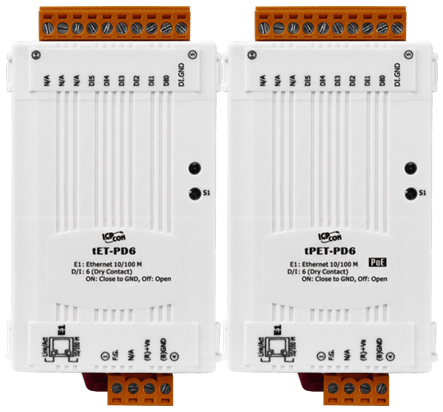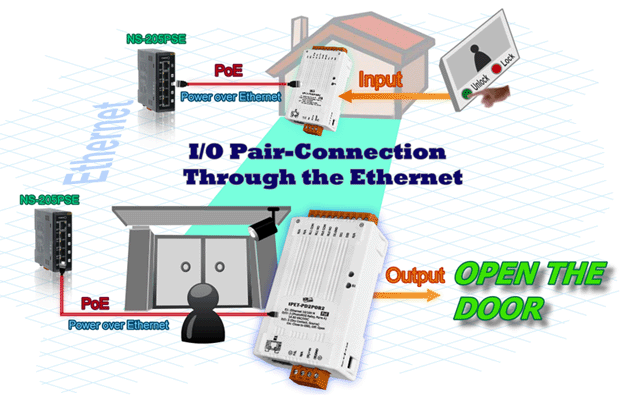tET-PD6/tPET-PD6 – Tiny Ethernet I/O Module(with PoE), 6-channel D/I (Dry Contact)
New Products
2013-12-13

Introduction
The tET/tPET-PD6 is an IP-based Ethernet I/O monitoring and control module which can be remotely controlled through a 10/100 M Ethernet network using the Modbus TCP protocol. Modbus has become a de facto industry-standard communications protocol, and is now the most commonly available method of connecting industrial electronic devices which makes the tET/tPET-PD6 perfect for integration with HMI, SCADA, PLC and other software systems.The tET/tPET-PD6 Ethernet I/O module supports digital input, and can be used to create DI-to-DO pair-connections through an Ethernet network. Once configuration is complete, the tET/tPET-PD6 module can be automatically poll the status of the local DI channels and then write the data to a remote DO device in the background using the Modbus/TCP protocol.

Built-in Web server
The t(P)ET series features a powerful 32-bit MCU that enables efficient processing of network traffic. It also contains a built-in web server that provides an intuitive web management interface that allows users to remotely modify the settings for the module, including the DHCP/Static IP and gateway/mask parameters, etc.
Built-in Dual Watchdog
The module provides a dual watchdog system that includes both a CPU watchdog and a host watchdog. The CPU watchdog automatically resets the CPU if the built-in firmware is operating abnormally, while the host watchdog sets the digital output to a predefined safe-value if there is no communication between the module and the host (PC or PLC) for a specific period of time (i.e., the watchdog timeout). The dual watchdog is an important feature which ensures that the module will operate continuously, even in harsh environments.
PoE and Low Power Consumption
The tPET series offers true IEEE 802.3af-compliant (Class 1 classification) Power over Ethernet (PoE) to receive power from a PoE switch, such as the NS-205PSE, using a standard category 5 Ethernet cable. If no PoE switch is available, the module can also be powered using a DC adapter. The t(P)ET series is designed for ultra-low power consumption, reducing the hidden costs that can accumulate due to increasing fuel and electricity prices, especially when a large number of devices are installed. Choosing energy-efficient equipment can minimize the amount of electricity consumed and make a positive contribution to environment.
PWM (Pulse Width Modulation)
The digital output channels on t(P)ET series modules provide a PWM (pulse generation) function that can be used to set different frequencies and duty cycles for each DO channel. In addition, the two DO channels can operate either independently or simultaneously, thereby reducing the complexity of the control system and enhancing the timing accuracy.
32-bit High Speed Digital Counter
Polling counter data via a remote host may cause quantity errors caused by communication delays. The tPET series module provides 32-bit counters that count the data locally, thereby solving problems resulting from any delay. The majority of products on the market today use 16-bit counters and only count up to a maximum of 65535. The 32-bit counter used in tPET series modules can count up to 4,294,967,296 and can accept a frequency of up to 3,500 Hz, so they are suitable for more applications such as production counting, ON/OFF switch counting, and event counting ,etc.
Frequency Measurement
Polling DI counts and calculating frequency value via the remote host can result frequency error caused by the communication latency. Rather than computing by host, the t(P)ET series directly calculates the frequency in site, thereby increasing the accuracy of the frequency measurement. The module provides three scan modes and four moving average methods that allow the user to select the most efficient approach for their purposes, making the module more suitable for a wider range of applications. This feature can also be used for both rotation and speed measurements.
Feature: |
||
|
 |
|
|
|
||
|
 |
|
|
|
||
|
 |
|
|
|
||
|
 |
|
For more information, please visit the tET-PD6/tPET-PD6 web site.

